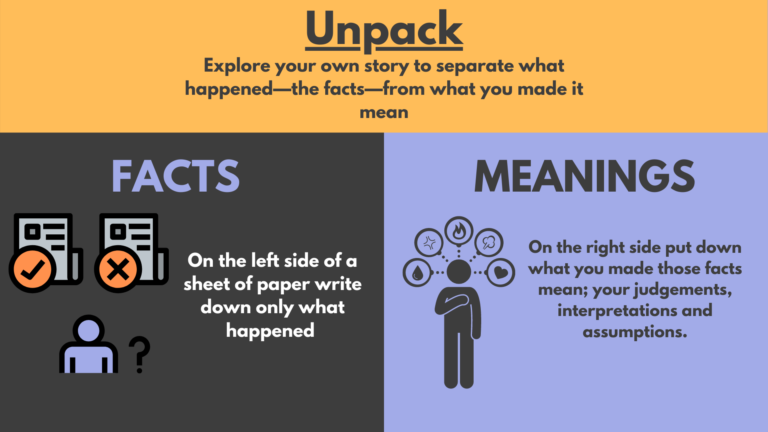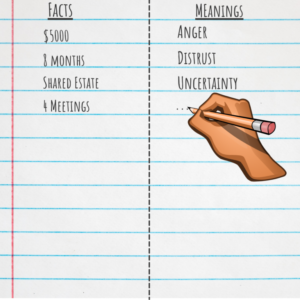
Turning Conflict Into Opportunity
Reading Time: 4 minutes
Conflict is inevitable and everywhere. Turning it into an opportunity is not as hard as you might think.
Imagine the final moments of a championship minor hockey game. The kids have played their hearts out and are locked in a tie game. The stands are filled with cheering family and friends. The referee misses a close call at the blueline and one team scores to win the game. Instantly half the stands are outraged, and half are ecstatic. If you were to meet with parents from each team the next day you would hear two very different stories of what happened and what they made it mean.
We can consider a number of conclusions about the nature of conflict from this simple example:
First – Conflict exists in our stories of the past about what happened to us and what we made it mean. When our stories are fundamentally different than someone else`s conflict is often the result.
Second – Conflict occurs when someone does something or fails to do something that blocks our access to what’s important to us. We think it shouldn’t be this way and so we react.
Third – When an event triggers a negative emotion such as anger, fear or frustration we can get trapped in our conflict stories. Our very identity can feel at risk and we focus on fault and blame, on who is right or wrong.
Fourth – We support our stories of conflict when we share them and their meanings with others in order to get them on our side. When we involve a lawyer, we expect them to champion our story.
We are always going to have different stories and different meanings because:
- We have different backgrounds and life experiences.
- We have different values and beliefs.
- We have different information.
- We interpret and judge differently.
- We have different interests and needs.
How to Get ahead and Stay Ahead of Conflict
The way we manage our conflicts has a tremendous impact on our success and satisfaction in life. When left unchecked conflict has the potential to deplete our time, energy and money. It can quickly sever relationships and erode our confidence in our future.
For more than 30 years I have helped people and organizations resolve conflicts as a mediator, facilitator and arbitrator. Most of that work occurred in the late stages of the conflict after much of the damage had been done.
I have shifted my focus from late resolution to early intervention to empower people to get ahead and stay ahead of conflict.
The Resolution Formula
Resolution occurs when we shift our focus away from fault and blame about what happened and how we were impacted, to the future and what we can do about it. This involves sharing our emotions and our meanings fully. The aim here is for understanding rather than a debate about right and wrong.
Based on this shared understanding we can co-create options for resolution that work for both parties’ interests and needs.
The Eight to Get Ahead and Stay Ahead of Conflict:
First – Recognize and accept that you have a potential conflict as early as possible. Step out of your story and look at it objectively
Second – Acknowledge your emotions but do not let them control you.
Third – Explore your own story to separate what happened—the facts—from what you made it mean— your judgements, assumptions and interpretations.
Forth – Based on your objective self-analysis make your best guess as to how the other parties see the facts and what they make those facts mean. Put yourself in their shoes and unpack their story for facts and meaning.
Fifth – Consider what needs to be done with the other side to confirm the facts for both parties. Agreeing on the facts or on a plan to establish the facts is the basis for resolution.
Sixth – Based on your newfound clarity about both stories, identify the interests, needs and concerns that are most important for each party. Those interests and needs are the building blocks of your options for the future.
Seventh – Reach out to the other party and invite them to engage with you in a dialogue about a future resolution. Share what you have done to prepare and why.
Eighth – Meet with the intention to have a dialogue about the future rather than a debate about the ‘rights’ and ‘wrongs’ of the past.
Get Help
You do not have to deal with conflict alone. Family and friends may help you stay objective and focused on resolution. Advice from your professional advisors such as accountants, estate and financial planners and business coaches may be very useful in keeping you on track towards future possibilities rather than focused on past grievances. Depending on the nature of your conflict, lawyers, mediators, or conflict coaches can be retained. Just remember, earlier is always better.
Following these eight steps will empower you to resolve and minimize your conflicts. For more information about these steps or for other assistance with conflict management please contact us at :
403-801-0234
Below are some of the services we offer:
- Conflict Management Coaching.
- Custom Designed Dispute Resolution Processes.
- Neutral 3rd Party Mediation and Facilitation,
- Workshops and Training Programs.







